Non-Perturbative QCD parameters
Latest averages used in the analysis in this page can be found in:
V. Lubicz and C. Tarantino, "Flavour physics and Lattice QCD:
averages of lattice inputs for the Unitarity Triangle Analysis"
arXiv:0807.4605 [hep-lat]
Our latest paper on this lattice analysis within the Standard Model can be found in:
M. Bona et al. [UTfit Collaboration], "The Unitarity Triangle Fit in the
Standard Model and Hadronic Parameters from Lattice QCD: A Reappraisal after the
Measurements of Δms and BR(B → τν)"
hep-ph/0606167
Method and results for the extraction of the Non-Perturbative QCD parameters:
Extraction of Non-Perturbative QCD parameters
Given the abundance of constraints now available for the
determination of the CKM parameters, ρ and η, we have the
possibility of removing from the fitting procedure the use of the
hadronic parameters coming from lattice calculations, letting
them as free parameters of the fit. In this way we can compare
the uncertainty obtained on a given quantity through the UT fit
to the present theoretical error on the same
quantity. Practically to obtain the a-posteriori p.d.f. for a
given hadronic quantity, we perform the UT fit imposing as input
an uniform distribution in a range much larger than the expected
interval of values assumed for the quantity itself. This
approach allows for the possibility of making a full UT analysis
without relying at all on theoretical calculations of hadronic
matrix elements for which there was a long debate about the
treatment of values and error distributions. We can then extract
from the combined experimental measurements the value of
BK and of the B0 mixing amplitudes
fB(s,d)√BB(s,d)
(or equivalently
fBs√BBs and
ξ) and compare them to the theoretical predictions.
It is important to stress that, as firstly stated in this UTfit
paper and contrary to what was previously done, the bounds
on Δmd and Δms enter into the
analysis through ξ and fBs√BBs, which are the
parameters better determined from the lattice and whose
systematic uncertainties are mostly uncorrelated. This strategy
changes the equations
that relate the experimental quantities to ρ and η
Below we show the one-dimensional distributions and the numerical
results for the various lattice quantities obtained using in the
fit all the available constraints on the angles (α, β,
γ that is the UTangle fit) plus the one coming from
the semi-leptonic decays (Vub/Vcb). We
exclude those constraints requiring the lattice QCD calculations
(Δmd, Δms, and
εK). In the table at the bottom of the page,
we compare the lattice inputs used in the UTfit analysis with the
predictions obtained from the angles and
angles+Vub/Vcb fits.
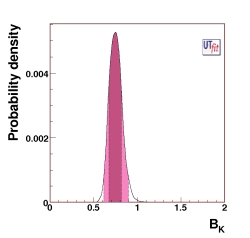
(EPS)
[JPG]
|
|
p.d.f. of BK from the UTangle + Vub/Vcb
BK = 0.74 ± 0.07
|
|
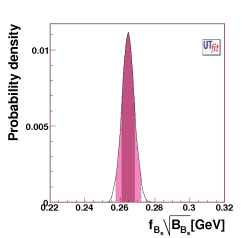
(EPS)
[JPG]
|
|
p.d.f. of fBs√
BBs
from the UTangle + Vub/Vcb
fBs√
BBs = (264.7 ± 3.6) MeV
|
|
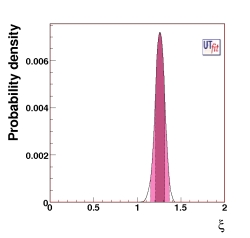
(EPS)
[JPG]
|
|
p.d.f. of ξ from the UTangle + Vub/Vcb
ξ = 1.26 ± 0.05
|
|
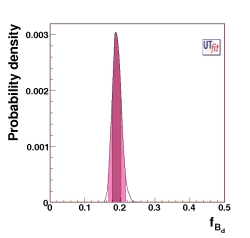
(EPS)
[JPG]
|
|
p.d.f. of fB from the UTangle + Vub/Vcb
fB = (191 ± 13) MeV
|
|
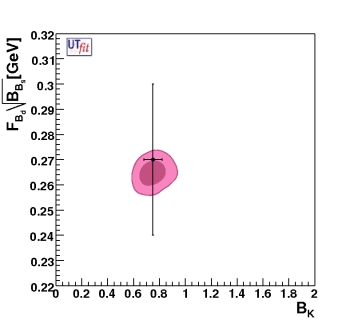
(EPS)
[JPG]
|
|
The 68% and 95% contours in the
fBs√BBs(MeV)-
BK plane
|
|
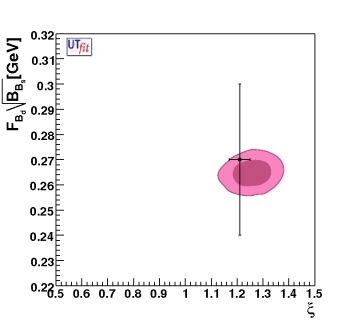
(EPS)
[JPG]
|
|
The 68% and 95% contours in the
fBs√BBs(GeV)-ξ plane
|
|
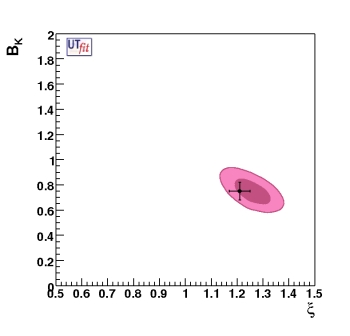
(EPS)
[JPG]
|
|
The 68% and 95% contours in the
BK-ξ plane
|
|
Results for the lattice QCD parameters
We quote below the numerical results for the lattice QCD
parameters in two different UT fit configurations: the one
described above that is using only the angles (UTangle) and
the one including also the Vub/Vcb
constraint from the semi-leptonic decays (UTangle +
Vub/Vcb). For reference also the lattice QCD
experimental values are reported in the last column (ref.
arXiv:0807.4605v1 [hep-lat]).
|
Parameter
|
UTangle
|
UTangle + Vub/Vcb
|
lattice QCD results
|
|
BK
|
0.78 ± 0.07 |
0.75 ± 0.07 |
0.75 ± 0.07 |
|
fBs√BBs
(MeV)
|
265.6 ± 3.6 |
264.7 ± 3.6 |
270 ± 30 |
|
ξ
|
1.27 ± 0.05 |
1.26 ± 0.05 |
1.21 ± 0.04 |
|
fBd (MeV)
|
191 ± 13 |
191 ± 13 |
200 ± 20 |
